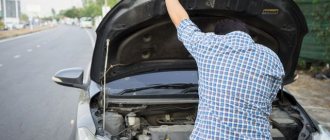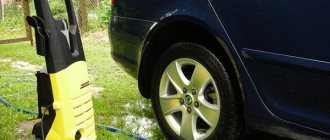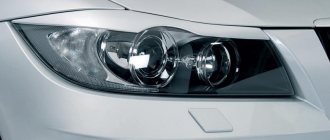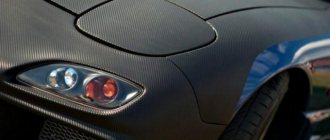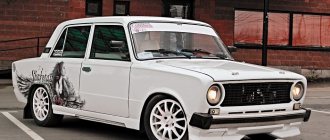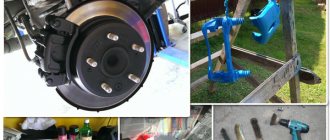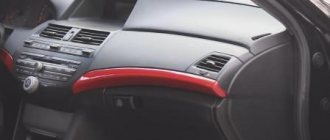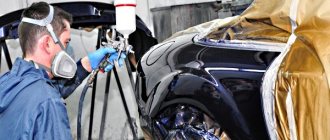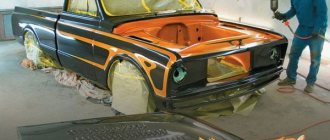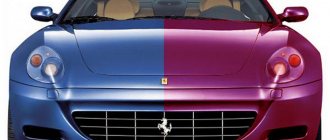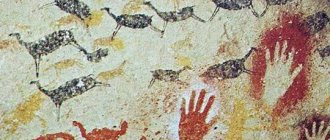Types of camouflage painting
Camouflage is a method of camouflage inherent in military uniforms, weapons and equipment. It is precisely for the ability to camouflage a car against the background of the environment that camouflage coloring is highly respected among those who like to hunt and fish: a car can literally blend into its surroundings.
Despite the existence of traditional brown-green-yellow colors, there are other camouflage options - winter, urban, forest and many others. They differ in color, type of pattern, and method of application.
For the final coating, varnishes with the following effects are used:
- glossy - gives shine in the sun, which eliminates camouflage, is often used to comply with fashion trends;
- matte - ideal for creating camouflage coatings for hunting, fishing, and military purposes.
It’s worth taking a closer look at the options for camouflage colors and pattern types to choose the one that’s right for you.
Traditional camouflage
This is a pattern in the classic khaki style, combining non-staining, discreet dusty earth tones with marsh and brown. Gives the car a real military look, ideal for camouflage, but poorly suited for urban conditions and everyday driving.
Geometric camouflage
This pattern is often called chopped. It provides an original design effect - “crushing” the silhouette of an object into parts. Most often, geometry is used on sports cars with a low body height. Also, a similar color is used by the US Army on fighter aircraft. Traditionally, gray, black and white colors are used to create decor, but in unusual versions you can even find pink and purple inserts.
Urban camouflage
Intended for driving in city conditions, it has a number of specific features: the predominance of gray, blue, white, the presence of angles and straight lines.
Digital or pixel camouflage
This design is incredibly stylish, rare, it resembles a combination of small squares that imitate digital pixels, which are noticeable when you magnify the monitor screen. The appearance of the car will look blurry relative to the terrain, despite the angular outlines of the decor. Color combinations can be similar in tone or contrasting - at the request of the owner.
Forest or hunting camouflage
Forest camouflage is a pattern based on dark green, beige, black spots with smooth, soft lines. It is most often chosen by hunters; it is also used to paint military equipment. A type of forest camouflage includes images of grass, vines, shrubs, and savannas.
Winter camouflage
The pattern within winter camouflage imitates nature during the cold season. The most popular colors are gray, white, blue in the form of blurry spots on a light background. Corners and edges can also be used, but in a minimal amount.
White camouflage
It is a subspecies of winter camouflage with the difference that the predominant color is white. It is usually applied by those who hunt in the taiga forest in winter, as well as for military purposes in the North.
Sand camo
Sand camouflage is also called “desert storm”. The main shades here are brown, yellow, and beige. The coloring is popular in the prairies, used by the military in the corresponding area. For application, they resort to the technique of spraying layers in different ways, and then they make the final finishing of the pattern with an airbrush.
Camouflage colors
There are seven basic colors offered by different camouflage paint manufacturers. This:
- black;
- brown;
- light green;
- olive;
- sand;
- khaki;
- grey.
In addition to standard tones, brighter colors are also used in the camouflage technique: white, blue and even pink, although they are intended only to add style to the car, but not to camouflage it. Typically, three colors from the list are selected to paint one car, although there may be more if desired by the owner. Masters also use other shades to give the drawing originality:
- light gray dust;
- beige;
- yellow-olive;
- brown skin;
- bronze green;
- anthracite;
- gray-olive;
- bitumen black;
- dark grey;
- bright gray etc.
Stencils for camouflage
How to paint a car camouflage with your own hands? For this purpose, the easiest way is to use special stencils. No less often, blanks are used in specialized services and tuning studios, although the price of professional painting in camouflage will be quite high. You can find a variety of stencils on the Internet, print and cut them out:
- blurry spots;
- outlines of animals;
- grass;
- branches;
- net;
- cells;
- "blots";
- leaves;
- stripes;
- geometry, etc.
It is better to print several identical stencils so as not to transfer them, but to immediately cover a large surface area. You can also create a drawing yourself, then cut it out and apply it in the same way. In addition to paper, for this technique of painting a car, you can take a transparent film, which is used by airbrush masters. It is a little sticky, so it is very convenient to work with. The required shapes are cut out of the film, glued to the base, and after the paint and varnish material has been applied and dried, they are removed.
Paper and cardboard option
Another material for making a template can be thick cardboard. When using it, we go the following way:
- We draw a pattern element on paper or find a pattern on the Internet, print it out and break it into fragments.
- Glue the paper with the pattern using PVA glue onto thick cardboard and let it dry.
- Using a razor or a sharp paper knife, cut out a template in cardboard according to the design that we will use when painting the car.
It is likely that you will need to break a complex design into several fragments - then you will have several stencils to work with.
Choice of colors for camouflage
It is most convenient to use paints in cans, produced by many companies specializing in auto enamels. There are even special series of camouflage colors from which you can choose the right ones. Most paints have a matte finish when dry, although glossy options are also easy to find. The most popular paintwork materials for camouflage painting are described below.
Paint Motip Enamel camouflage
The Motip Camouflage aerosol line is sold in 400 ml cans and includes specially designed colors to create a “military” look on any surface. The paint helps to camouflage a car for hunting and fishing; it is also suitable for hunting equipment and accessories that a person carries in the forest. The finished coating is resistant to gasoline, other chemicals and atmospheric factors.
Painting "Raptor" in camouflage
Painting with "Raptor" - a high-quality polyurethane paint - is widely used among lovers of off-road driving. This material provides reliable protection of the body from salts, aggressive chemicals, mechanical stress, temperature changes, and UV radiation. The “military” coloring gives the equipment a memorable, but at the same time camouflaging design. The coating will adhere remarkably well to plastic, bumpers, mirrors, radiator grilles, and will prevent water and dirt from getting into the gaps between plastic and metal parts.
Gun paint KRYLON Camouflage
Krylon Camouflage is a matte anti-reflective paint designed to simulate protective and camouflage finishes. It is intended for creating coatings on cars, sports, hunting or fishing equipment and inventory. All shades of this harmoniously selected range are close to nature and therefore guarantee perfect camouflage.
The paint has excellent adhesion to plastic and metal even without prior priming. The finished coating will be resistant to water, durable, and can withstand mechanical loads well. The paintwork dries in just 15 minutes, which is very convenient for use outside a car repair shop. A second coat can be applied after a day. Final polymerization occurs after 7 days.
Features of applying varnish to a car body
Experts recommend applying a special varnish to the body, which has an attractive matte effect. This composition gives the surface a special velvety structure. It is worth noting that the technology of applying varnish is no different from simple varnishing.
It is worth noting that a solvent is added to the varnish before applying it, as well as a special hardener.
The quantity must be strictly as indicated in the instructions. Often these parameters change from one layer to another. For example, for the lowest one, a composition that is more liquid in consistency is used, which is characterized by fluidity. The last layer will require the use of a more concentrated layer, which is thicker.
The varnish is applied to the car in approximately 2-3 layers, before directly applying each of which you need to wait some time to dry it. You can check with your hands; as soon as your fingers stop sticking, you can begin applying the next layer.
The vehicle will look even more original if the spots are made large enough to cover various elements of the body. A special protective screen, also made from newspapers, is formed strictly along the contour of the spots. By doing this, you can avoid painting the excess area black.
It is recommended to begin the process of painting stains on a car of a different color after two or three hours, that is, after the previously applied stains have completely dried. To make the car’s camouflage as seamless as possible, the spots must be drawn overlapping.
Applying each layer strictly in two layers is able to provide a rich, opaque color. This is especially true for the green color shade, it is the lightest. In the process of drawing spots, you should move strictly clockwise, with all the body pillars and, accordingly, with the roof.
Preparation of paint, materials and surface
Typically, a camouflage pattern is applied to the factory body coating, which will serve as a base. Paint consumption is 5-6 cylinders for a medium-sized car. In addition to paint, you need to prepare the following tools and consumables:
- sandpaper;
- painting spatula;
- soft rags;
- construction tape;
- solvent, gasoline, alcohol;
- newspapers.
It is best to paint a car in a well-ventilated garage or outside, and then only on a clear sunny day. As preparation, cover with newspapers and seal with masking tape all elements that cannot be painted - glass, handles, rubber seals, headlights. Afterwards, the surface of the car is degreased using solvents, after making sure that they are safe for existing paint (it is better to use regular alcohol or gasoline).
Cigarette paper
Tissue paper can be an interesting medium for stenciling. It is very thin - you can make various tears in it in a chaotic manner. After that, we attach it to the car body with tape and spray it with paint.
For each color you will have to use a new stencil - you will get smooth transitions from one color to another, which will look very impressive.
This option is also used for applying camouflage to equipment.
Applying paint
Stencil painting is the easiest way to apply camouflage, although in this case all the spots and patterns will be exactly the same. There is an option to use different stencils, although this method will increase the time spent on painting. The procedure for painting a car is as follows:
- stick the stencil on the surface of the car;
- apply aerosol paint, placing it 20 cm from the body (movements should be smooth and have a diagonal direction);
- wait until the paint dries;
- remove the stencil, repeat all manipulations in the following areas.
Masters advise applying dark spots first, which will serve as a basis for lighter ones. When applying a stencil, it is important to avoid creases and damage to the paper - in this case, the paint will end up under the workpiece, and the design will look untidy. The decor looks original, in which large spots extend from one part of the body to another.
How to make camouflage on a car using film
Car vinyl camouflage
Most likely, people will gather who are interested in creating and implementing a design for their car using film wrapping. Today, one of the most popular layouts is camouflage. Camouflage can be of different types and shades. City, cow, urban, snow and many many other options. We will look at the production and application technology.
Film camouflage can be done in several ways. It all depends on your wallet and the final look. We will go from simple to more complex and expensive.
But before discussing application, you must have a design layout based on which you can print or cut the film. To do this, contact us, we will help you create an interesting project.
Camouflage cut on a plotter
Since everyone reads these articles, I must tell you in a nutshell what a plotter is. A plotter is equipment designed for cutting stickers or other elements on film according to a created layout. This is one of the simplest types of applying camouflage to a car. We take a layout made by a designer; the layout must be prepared for plotter cutting. We give it to the advertising agency along with our film; more about choosing a film below. The cost of cutting work varies in different regions, from 100 rubles per sq. meter. For a cut out model for the entire car you will pay about 1-3 thousand rubles.
Let's move on to application. The color of the car can be any, you can put pieces on the original body, or you can pre-paste the car in some color suitable for you, and put camouflage on top. Next, we place the cut out pieces around the car using a soap solution, looking at the design layout. If you are experienced enough, you can do it using the dry method. After all procedures, be sure to heat the film to 60-70 degrees - this will add reliability when washing high pressure.
Choosing a film for camouflage - the main parameter of this film is the presence of channels. I highly recommend using the ductless series. The presence of microchannels for air removal creates extra micro holes for water to enter, which subsequently leads to the destruction of the piece. For camouflage cut on a plotter, use the oracal 551, avery 700
Key points in the work:
- design layout required
- we use channelless film
- series of films for work oracal 551, avery 700
- warming up to 60-70 degrees
- Only solid colors can be used
Price: film - ~500 rub. sq.m. plotter ~200 RUR sq.m. Material for a golf class sedan will cost about 10-12 thousand rubles.
For clarity, I recommend watching how we glued the Mercedes. It is in the second of three parts that the cutting plotter method is used.
Camouflage using a thread knife or masking tape
The second option can be done using a thread knife; the difficulty is to accurately transfer the design from the layout to the car. You will have to align all the lines as carefully and scrupulously as possible, and working with a thread knife requires some practice. It takes about one roller 50 meters per car. It is also worth noting that knifless finish line is suitable for chopped camouflage, and knifeless design line for cow camouflage. A thread knife is an excellent solution for a beginner; you will never cut the body with a blade, unlike the next method - camouflage using masking tape. The tape should be 2-3 cm wide. Such tapes can be slightly bent; the thicker the tape, the more difficult it will be to bend and the smoother the line will be. The choice is yours. We glue a piece of film, then align the cutting lines with the tape and carefully cut along the tape, pay attention to the pressure of the knife, you can cut the film through and damage the paintwork. For curved lines there is molar tape, it is much narrower and softer than tape.
Key points in the work:
- design layout required
- for straight lines we use knifelfess finish line
- for curved lines we use knifeless design line
- we use channelless film
- series of films for work oracal 551, avery 700
- warming up to 60-70 degrees
- Only solid colors can be used
Price: film - ~500 rub. sq.m. thread-like knife - 1500 rubles - 2000 rubles for 50 meters.. Material for a golf class sedan will cost about 10-12 thousand rubles.
Camouflage - partial covering with printed film
This method includes two technologies - printing and plotter cutting. This method allows you to use any colors, gradients or designs. You need to print the layout and laminate it, then cut out this image along the contour. In the second step, we repeat the process described in method 1. There is a peculiarity with printing - it needs to be laminated, this is the only way to protect the image from scuffs and fading. The laminate (transparent film) is selected according to the type of manufacture and this type must match the printed film. For example, polymer film for printing and polymer laminate, cast film for printing and cast laminate. Use the middle price segment of printed films - orajet 3551 + oraguard 215
Key points in the work:
- we use channelless film
- series of films for work orajet 3551 + oraguard 215
- warming up to 60-70 degrees
- any range of colors, gradients or images
Price: film - ~700 rub. linear meters, laminate ~700 rub. shoulder straps m.. Printing ~ 500 rubles per sq.m. Lamination ~300 RUR/sq.m. 1 meter of such a sandwich will cost 2-2.5 thousand rubles. You will have to spend about 40 thousand rubles on a sedan.
Camouflage - full covering with printed film
The most energy- and money-consuming option, the most beautiful and seamless. We repeat the printing and lamination procedure; in this method there is no need to cut anything on the plotter. I do not advise a beginner to use this option; applying an image without constrictions to a car in one piece is a very difficult procedure. Add to this the matching pattern on the bumpers, hood and trunk. Here you can use a film with channels; the film is wrapped inside all the elements. A complex bumper is combined with a black matte or glossy film to reduce tension in difficult recesses. Only cast film with cast laminate is used, for example orajet 3951 + oraguard 290 or avery 1000 + dol 1000
Key points in the work:
- Difficulty in applying full color printing
- only cast films and laminates
- series of films for work orajet 3951 + oraguard 290 or avery 1000 + dol 1000
- heating up to 100-110 degrees in difficult recesses
- any range of colors, gradients or images
Price: film - ~1000 rub. linear meters, laminate ~1000 rub. shoulder straps m.. Printing ~ 500 rubles per sq.m. Lamination ~300 RUR/sq.m. 1 meter of such a sandwich will cost 3-4 thousand rubles. You will have to spend about 50-60 thousand rubles on a sedan.
I must warn you - do not use Chinese films with ready-made camouflages, this is an option for a couple of weeks. The films have poor adhesive and are not protected by laminate.
@Vlidimir Kireev
Additionally:
Tags
camouflage, training, film
Method of painting camouflage without a stencil
This method is more difficult; it requires skill and patience from the performer. First, choose a pattern and color scheme. After preparing the machine, painting is carried out as follows:
- Using narrow construction tape, large spots are formed on the surface of the body, making sure that the strips lie without creases;
- cover the spots with newspapers, giving the lines smoothness, and also glue them with tape;
- apply the darkest color from the can and let the paint dry;
- remove tape and newspapers, form spots to match the second color (they should overlap the first);
- apply paint in the same way;
- repeat the work a third time, applying the lightest shade.
After painting, the body is varnished. To do this, car varnish is combined with a solvent and the body is sprayed in several layers. After the varnish has dried, you can begin operating the car, making full use of the masterpiece you created with your own hands.
We coat the car with varnish
After finishing painting, it is necessary to cover the surface of the car with matte varnish. It will create a rough surface structure.
Next, the varnish is mixed with solvent and fixative. The consistency may vary depending on the layer. The first layers are usually more fluid, the last ones are thicker. All mixing proportions should be maintained according to the instructions.
UAZ Bukhanka in camouflage. Tuning in a new light.
Cost of all equipmentOn request
